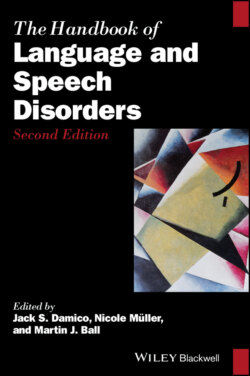Читать книгу The Handbook of Language and Speech Disorders - Группа авторов - Страница 44
3.2.4 Hearing Loss and Cochlear Implants
ОглавлениеThe CI, which as both a neural prosthesis and a device that facilitates communication, has transformed the treatment of hearing loss by offering an alternative to amplification for those with severe and profound hearing loss. A descriptive model of the aural acuity of a typical adult patient has been developed from the analysis of a large multicenter study (n = 2,251) of factors that influence CI candidature (Lazard, Vincent, et al., 2012) (see Figure 3.2). To perform this regression over different languages, speech materials and clinical protocols, postoperative speech scores in quiet were transformed into percentile rankings of patients within each center, and these are the basis for the “auditory performance” axis shown in Figure 3.2. The model shows, among other things, the effect of hearing aid use in the period prior to implantation where the typical candidate has a severe or profound hearing loss. If bilateral hearing aids (HA) are fitted and worn in this period, the expected rate of decline in auditory performance is approximately half that of the rate of decline if HA are not used. This adds important detail to the previously observed robust factor of “duration of deafness,” where longer time periods between the onset of profound hearing loss and implantation were associated with significantly poorer speech perception scores (Blamey et al., 1996). The model also shows that the postoperative ranking is better in the phase where the patient learns to listen with their CI, provided that they had used HA in the period prior to implantation.
Figure 3.2 Descriptive model of an average postlingually deafened CI candidate showing auditory performance as a function of hearing ability over the entire patient journey. The duration of the decline of moderate hearing loss (mHL) and severe/profound hearing loss (s/p HL) is assumed to be 20 and 10 years, respectively.
Source: Lazard, D. S., Vincent, C., Venail, F., Van de Heyning, P., Truy, E., Sterkers, O., et al. (2012). Pre‐, per‐ and postoperative factors affecting performance of postlinguistically deaf adults using cochlear implants: a new conceptual model over time. PLoS ONE, 7(11): e48739. doi:10.1371/journal.pone.0048739
The results of this large‐scale data collection are important to our understanding of factors that contribute to successful CI candidature. In another analysis of the same data, Blamey et al. (2015) examined the postoperative results to investigate the relative benefits of the modality of listening (CI alone, CI and contralateral HA, and bilateral CI) and the side of implantation. Results from speech testing in quiet showed that bilateral CI recipients with poor preoperative performance were marginally better than CI recipients who used a contralateral hearing aid, an advantage that was also seen in comparison of the mean bilateral CI and the CI/HA results in noise. In analyzing the side of implantation, they did not find an asymmetry between the unilateral performance of recipients when only right‐ or left‐sided implants were active during testing (right and left unilateral implantations were approximately balanced). This suggests that for postlingually deafened adults the decision of which side to implant does not need to reflect a putative language‐specialized hemispheric dominance.
In terms of hardware CIs consist of an external ear‐level processor situated in housing that also contains microphone(s), battery and transcutaneous transducer. The implanted components include the receiver‐stimulator and the electrode array, which is surgically inserted into the Scala Tympani compartment of the cochlea. At the time of writing we note reports of fully implantable devices where all external components are subcutaneously implanted, and this trend has obvious cosmetic advantages.
